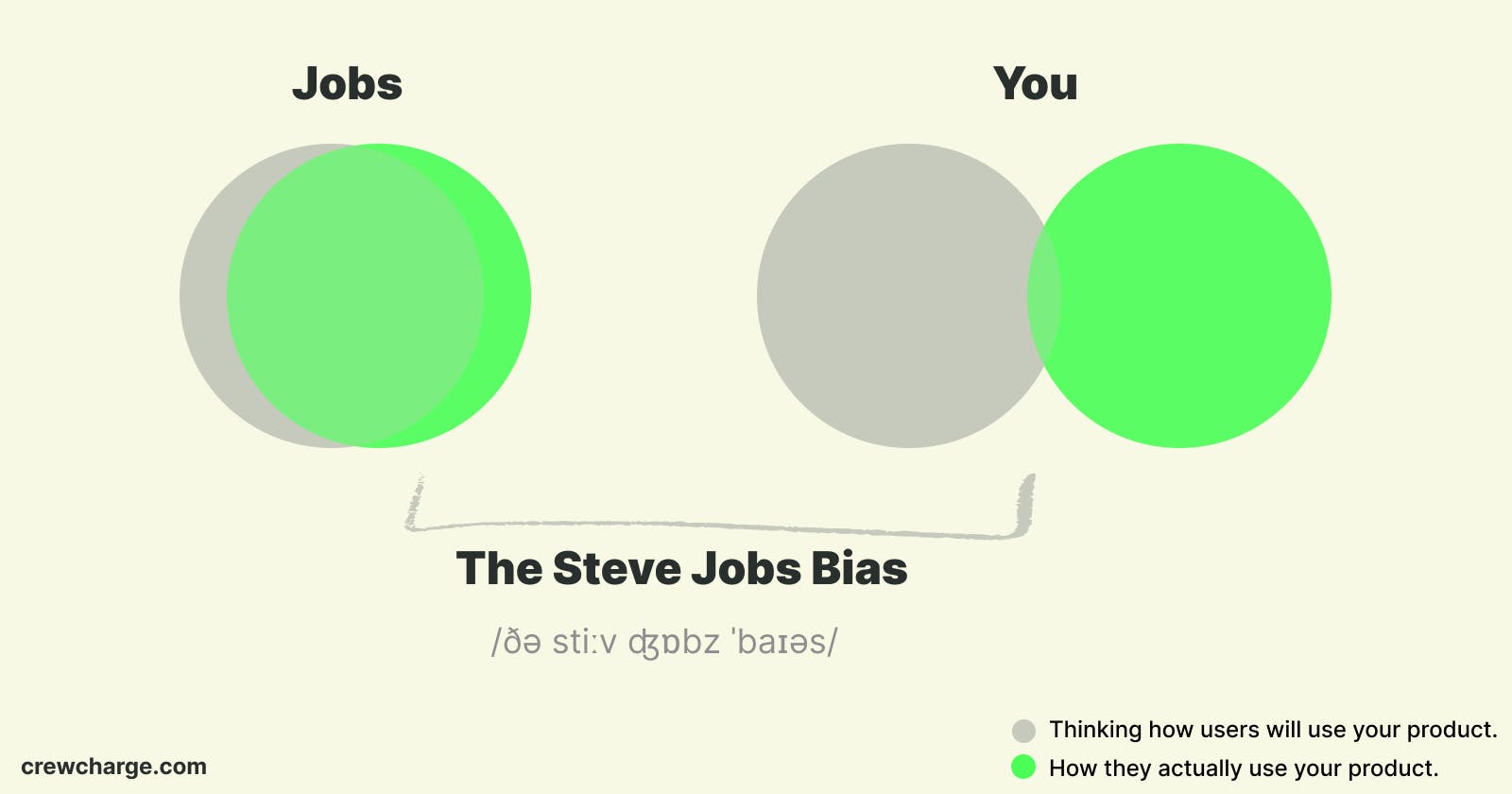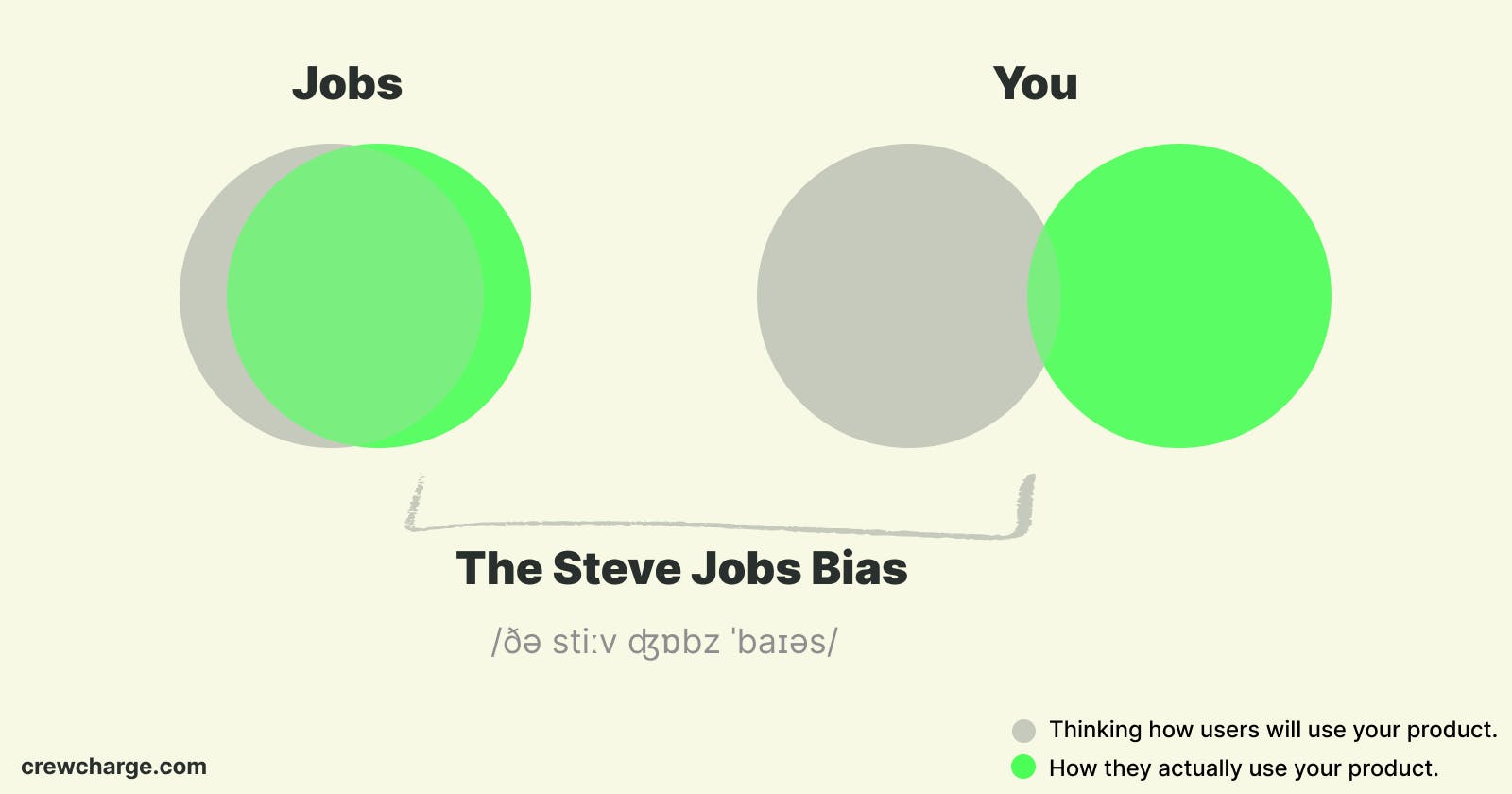The Steve Jobs bias that's killing SaaS startups.
The Steve Jobs bias is a mismatched gap between how you envision users will use your product - and how users actually use your product
Table of contents
- What is the Steve Jobs Bias?
- Why is it called the Steve Jobs Bias?
- 1. Stop asking customers what they want, instead rely on what they do.
- 2. Build an Ideal Customer Profile and sell to them, even if it's tougher.
- 3. Rely on Integrations to familiarize interaction, then build the platform.
- About the Author and Crewcharge
If you're an ambitious founder, there's a huge chance you might be a fan of Steve Jobs. Media loves him, founders love him, but could you damage your startup because you think you're him?
I recently consulted with 40+ early to mid-stage SaaS founders (mostly B2B) since January. I love letting them talk about their ambitious project, and see if I could add value to their application by testing it out. I signup for their project, identify areas where there's room for improvement in Customer Success so I could build a better product at Crewcharge.
But once I started to signup for more than 10–20 products a week, I identified certain patterns that held strong across the group. I found the root cause for certain apps and it turns out to be a bias in the founder's mind, which I call, "The Steve Jobs Bias"
What is the Steve Jobs Bias?

Simply put, the Steve Jobs bias is thinking the gap between how you envision users will use your product - and how users actually use your product is lower as opposed to reality.
Why is it called the Steve Jobs Bias?
Steve Jobs spent all his life obsessing about how humans interact with computers, and thus he was able to envision what consumers want.
One of the rather subtler examples would include how much he obsessed about the smaller things - like the iPhone box. Did you know Apple filed a patent for their packaging?
While we all try and want to be like him, a lot of us fail for a variety of reasons.
Let's see how you can avoid this bias,
1. Stop asking customers what they want, instead rely on what they do.
People will never know what they want until you show it to them. - Steve Jobs.
The fix for Steve Job's bias ironically also includes Steve Jobs. Don't get me wrong, you must always talk to your users.
But a lot of us delegate the product decision to our customers, this is wrong and could potentially put your company in a negative growth trajectory.
The way we help customers reach this at Crewcharge is simply through triggers and customer funnels.
If most of your customers haven't even visited feature A after multiple email campaigns, demos, and workshops - you should be asking yourself if building a sub-feature-a is the solution.
For example, if you want to build feature A, first create a page or screen for it with a button that reads "new". When users click on it, ask for information about what they want to achieve through the feature, not what the feature should be. Run the campaign for 2 weeks, before actually building the feature.

2. Build an Ideal Customer Profile and sell to them, even if it's tougher.
Storytime: When I worked for a company that sold software to enterprises, they could tell us what to build and it would get built. No product managers were involved. The problem was this enterprise was from a different industry we were used to selling to, hence they asked for features specific to their industry. Long story short, 3 months after development - customers churned, no one else wanted to buy the feature.
Lessons learned:
SaaS startups especially B2B must build their product on small businesses who make suggestions, not commands, and slowly start selling to enterprises when the startup by itself, is defined as a large enterprise. This was how Slack and HubSpot grew into multi-billion dollar companies.
Selling to one ideal customer is better than selling to two customers you know your software can't provide value to. When you have an ideal customer profile setup, you have a better idea of beating Steve Job's bias.
3. Rely on Integrations to familiarize interaction, then build the platform.
This would be the biggest anti-dote to the bias, where you focus on building integrations over building the product.
Does the user have a bigger chance of opening Google Calendar/Gmail, or a separate app I signed up for 4 days ago, and click on their calendar tab after closing 4 popups?
Some of the founders really build like it's 2000, and not 2022. Back in 2000, people hadn't interacted with products making it harder to first fix knowledge gaps on how to use your product.
But now, people have been using software for decades. I remember the UX of Facebook since 2007. Founders need to leverage this to their advantage, instead of re-inventing the wheel.
Some great examples:
- Loom's chrome extension beautifully sits on my Gmail and GitHub incentivizing me to use the product.
- Medium's weekly stat report follows the VVF framework for SaaS Conversions.
- Calendly's insane growth because of their easy integration with Google Calendar.
The outliers:
Notion is one outlier of this strategy. Sure they did integrate embedding features like tweets and youtube directly into a notion page, but they built something beautiful that didn't have to rely on 10 integrations to work.
Of course, one thing you might not have known about Notion has existed for over 9 years now. The lesson was also to do whatever you can to stop burning cash as a startup.
About the Author and Crewcharge
Bhardwaj Giridhar is the founder and CEO of Crewcharge - an all-in-one solution for SaaS companies to cut their SaaS churn in half.
We help SaaS companies be data-driven and build out marketing, customer success funnels, and feedback widgets in the blink of an eye.
Contact us for a free-no-strings-attach demo for your SaaS here.
Originally published at Linkedin

